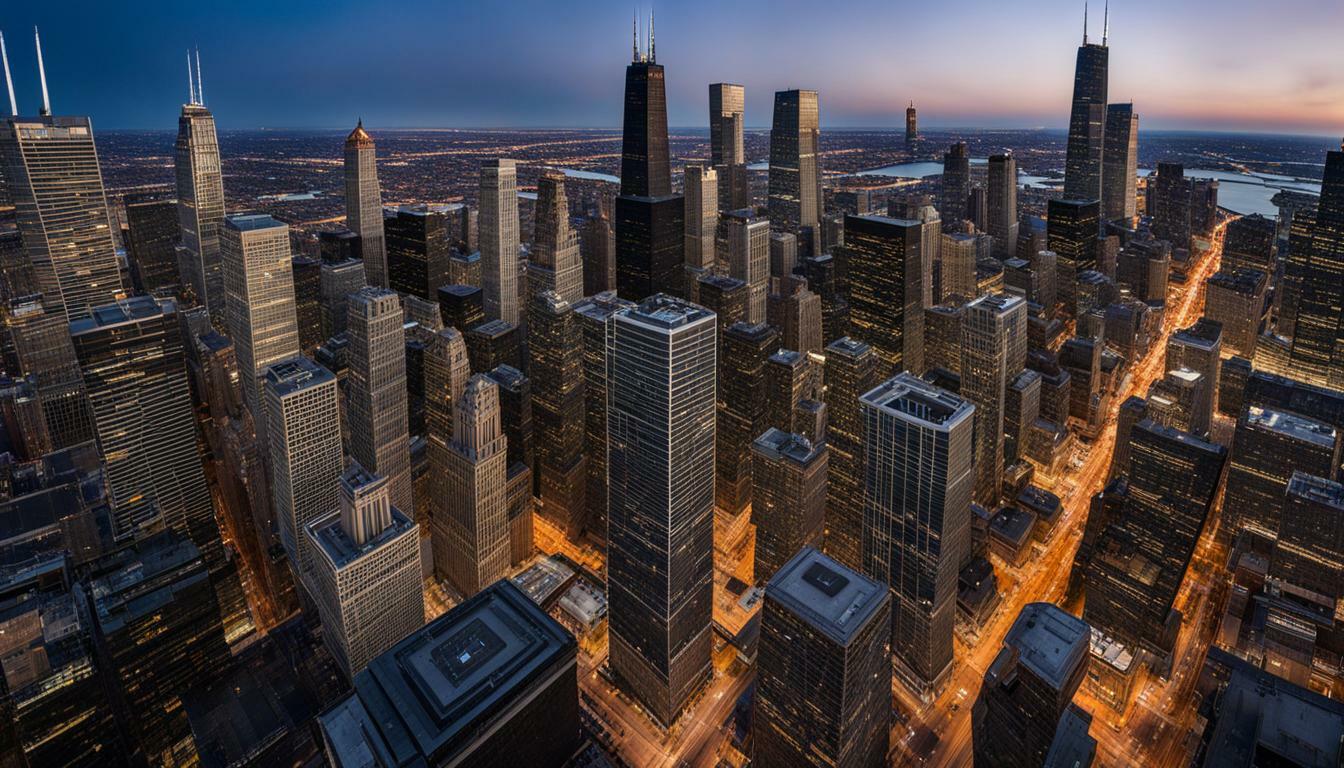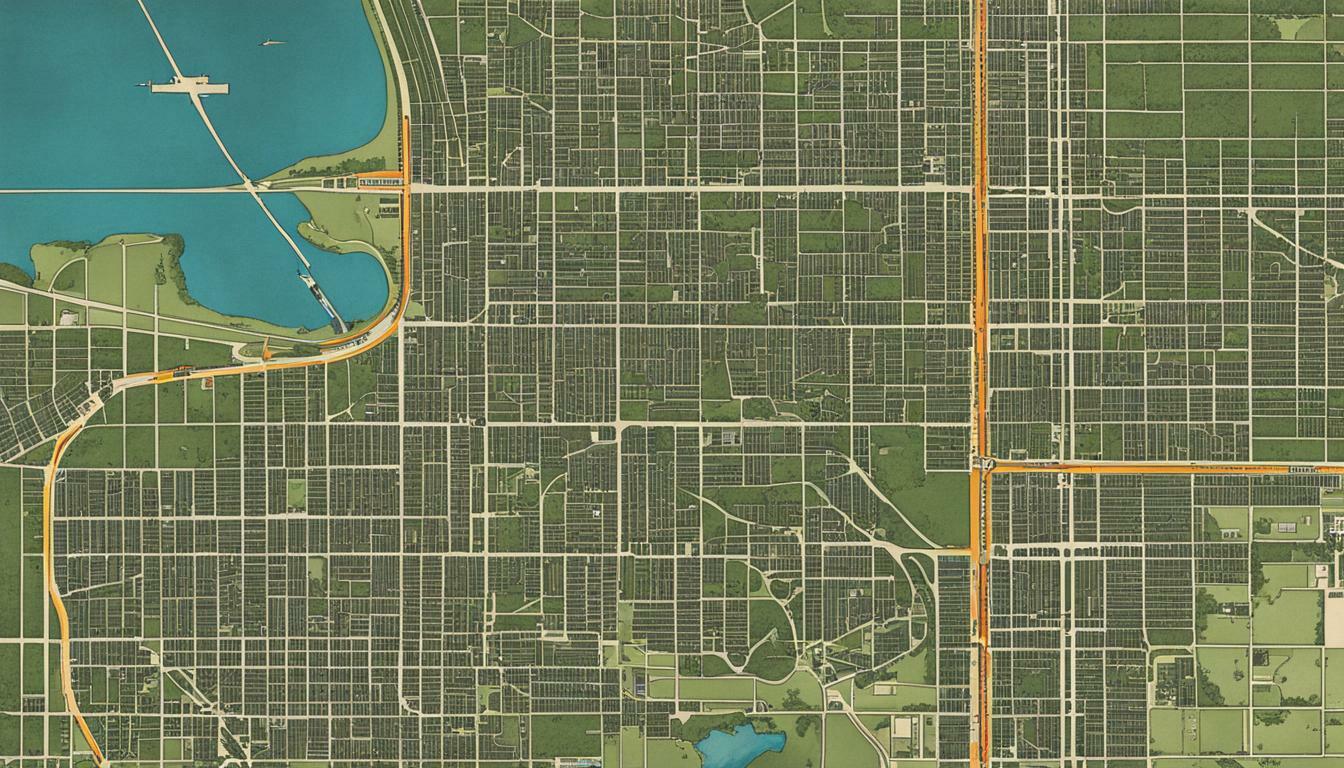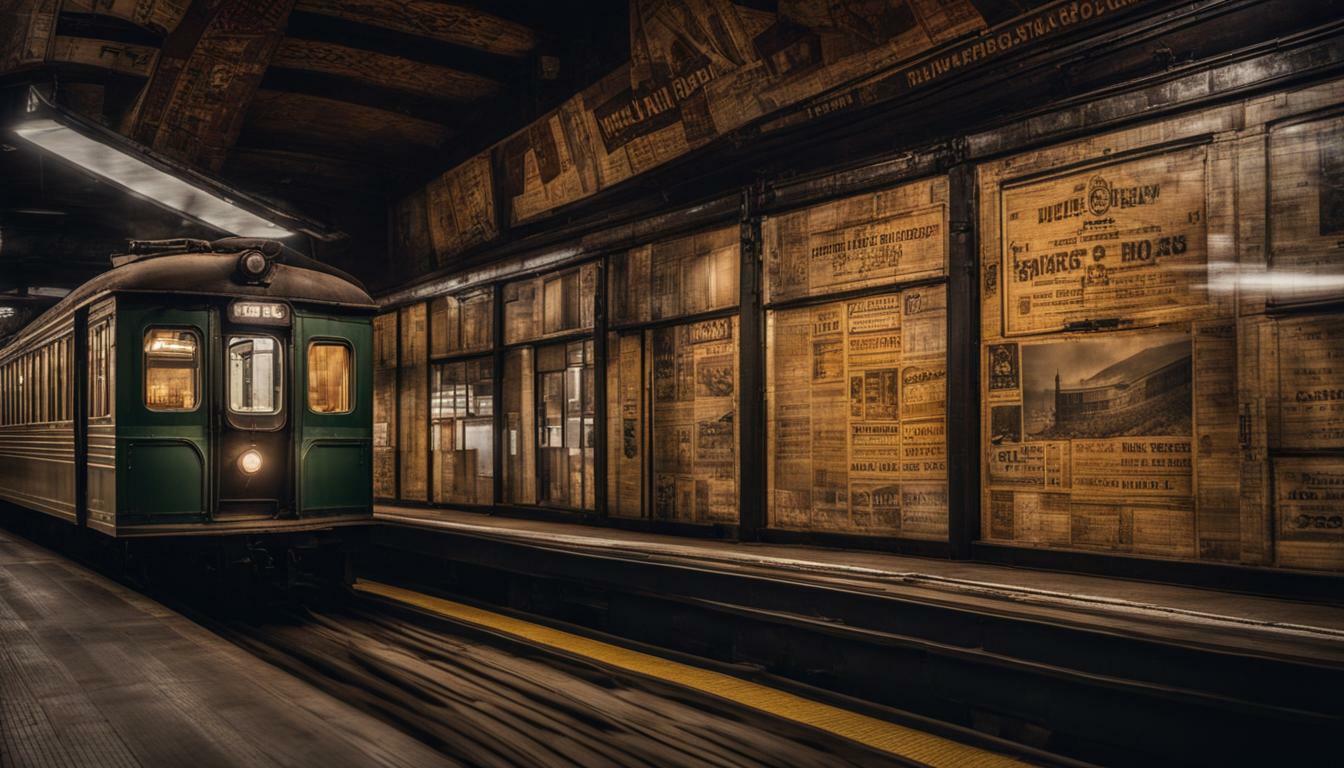The Willis Tower, previously known as the Sears Tower, is an iconic skyscraper that holds a rich history in the city of Chicago. Construction of this magnificent building began in 1970 and was completed in 1973, making it a symbol of architectural prowess and innovation. Designed by the renowned architects Skidmore, Owings and Merrill, and engineered by Fazlur Khan, the Willis Tower introduced the world to the revolutionary “bundled tube” design, which allowed it to be the tallest building in Chicago at that time. It served as the corporate headquarters for Sears Roebuck and Company, the world’s largest retailer, until 1988.
Key Takeaways:
- The Willis Tower, formerly known as the Sears Tower, is a historic skyscraper in Chicago.
- Construction of the tower started in 1970 and was completed in 1973.
- Skidmore, Owings and Merrill were the architects behind the design, while Fazlur Khan revolutionized the structure with the “bundled tube” design.
- Sears Roebuck and Company occupied the building until 1988.
- The tower is now known as the Willis Tower, named after the Willis Group, a London-based insurance broker.
Construction of the Willis Tower
Construction of the Willis Tower began in 1970 and was completed in 1973, making it the tallest building in Chicago at the time. Designed by the renowned architectural firm Skidmore, Owings and Merrill, and engineered by Fazlur Khan, the tower was a marvel of modern engineering and design.
The construction process involved innovative techniques to overcome the challenges posed by its immense height. The “bundled tube” design, created by Fazlur Khan, allowed the tower to withstand wind and gravity forces. This design consisted of nine rectangular tubes bundled together, providing structural stability while minimizing material usage.
The construction team worked tirelessly to bring the vision to life, using unprecedented methods to erect the tower’s 110 stories. The use of prefabricated modules and advanced construction equipment expedited the process, ensuring the timely completion of this architectural masterpiece.
Construction Milestones:
- Commencement of construction in 1970
- Completion of structural framework in 1971
- Installation of glass and interior finishes in 1972
- Official opening of the tower in 1973
| General Information | Facts |
|---|---|
| Location | Chicago, Illinois, United States |
| Architect | Skidmore, Owings and Merrill |
| Height | 1,450 feet (442 meters) |
| Total Floors | 110 stories |
| Main Use | Office and Commercial |
Today, the Willis Tower stands as an iconic symbol of Chicago’s architectural prowess, attracting visitors from around the world. Its construction not only pushed the boundaries of engineering but also solidified Chicago’s status as a global hub for innovative skyscraper design.
Architectural Prowess of the Willis Tower
The Willis Tower is renowned for its architectural prowess, with its innovative design and distinctive features making it an iconic landmark of the Chicago skyline. Designed by architects Skidmore, Owings and Merrill and structural engineer Fazlur Khan, the tower stands as a testament to their visionary brilliance. Using the revolutionary “bundled tube” design, Khan created a structural system that could withstand the strong winds and gravitational forces at such great heights.
The tower’s architectural significance lies not only in its structural integrity but also in its towering height. Standing at 1,450 feet, it held the title of the world’s tallest building for 25 years, a feat that solidified its place in history. The Willis Tower’s sleek silhouette and striking presence have become synonymous with the city of Chicago, captivating both locals and visitors alike.
As an architectural landmark of Chicago, the Willis Tower boasts several intriguing facts and features. Its unique black aluminum and bronze-tinted glass façade create a visually stunning exterior, reflecting the changing colors of the sky. The tower’s observation deck, the renowned Skydeck Chicago, offers breathtaking views of up to 50 miles in each direction, providing visitors with a panoramic experience like no other.
Notable Willis Tower Facts:
- The Willis Tower was the first building to use the innovative bundled tube structural system.
- The building features nine sky lobbies, enabling efficient vertical transportation.
- It has 2.15 million square feet of rentable space, accommodating numerous corporate offices.
- The tower’s elevators are among the fastest in the world, reaching speeds of up to 1,600 feet per minute.
| Height | Floors | Construction Start | Construction Completion |
|---|---|---|---|
| 1,450 feet | 110 floors | 1970 | 1973 |
The Willis Tower’s architectural splendor, historical significance, and enduring legacy make it a true gem in the heart of Chicago. Its innovative design and distinct features have solidified its status as an architectural landmark, captivating the imagination of all who behold it. Whether referred to as the Willis Tower or the Sears Tower, one thing remains certain – its towering presence will continue to inspire awe for generations to come.
Sears Roebuck and Company
Sears Roebuck and Company, the world’s largest retailer at the time, played a significant role in the history of the Willis Tower. When the tower was completed in 1973, Sears Roebuck and Company became its primary occupant, leasing a large portion of the building for its operations. For more than a decade, the company established its headquarters in the iconic skyscraper, further solidifying the tower’s status as a symbol of Chicago’s economic might and architectural excellence.
During its occupancy of the Willis Tower, Sears Roebuck and Company occupied approximately three million square feet of office space, making it one of the largest tenants in the building. The company’s presence in the tower was a testament to its prominence in the retail industry and its commitment to being at the forefront of business innovation.
The Sears Tower represented more than just a headquarters for Sears Roebuck and Company; it was a reflection of the company’s ambition and influence. With its striking design and record-breaking height, the tower served as a physical manifestation of the company’s dominance and entrepreneurial spirit.
While Sears Roebuck and Company eventually moved its headquarters out of the Willis Tower in 1988, the impact of its occupancy remains ingrained in the building’s history. The company’s association with the tower during its formative years added to the allure and prestige of the structure, and its legacy continues to be remembered and cherished by both locals and visitors alike.
Renaming to the Willis Tower
In 2009, the Sears Tower underwent a name change and became known as the Willis Tower, after the London-based insurance broker, the Willis Group. This renaming sparked a wave of discussions and mixed reactions among locals and visitors alike. While some embraced the new name, others clung to the tower’s original moniker, continuing to refer to it as the Sears Tower.
The decision to rename the iconic Chicago skyscraper came after the Willis Group secured a leasing deal for a significant portion of the building. The renaming was seen as a strategic move to enhance the global presence and brand recognition of the Willis Group. However, the new name did not diminish the tower’s status as a symbol of Chicago’s architectural and cultural heritage.
Despite the name change, the Willis Tower remains deeply embedded in the collective memory of Chicagoans. Its distinctive silhouette against the city skyline and its historical significance continue to make it a beloved landmark. Whether you call it the Willis Tower or the Sears Tower, there’s no denying the impact that this towering structure has had on the identity and pride of the Windy City.
| Former Name | Current Name |
|---|---|
| Sears Tower | Willis Tower |
The Willis Tower Observation Deck
The Willis Tower’s observation deck, known as the Skydeck Chicago, offers breathtaking views and is a must-visit for tourists and locals alike. Located on the 103rd floor of the iconic skyscraper, this elevated platform provides an unparalleled vantage point to take in the stunning beauty of Chicago’s skyline.
Upon stepping onto the Skydeck, visitors are treated to a 360-degree panorama that stretches for up to 50 miles in every direction. The sweeping vistas showcase the city’s architectural wonders, including the glittering lights of downtown, the vast expanse of Lake Michigan, and the majestic backdrop of the surrounding neighborhoods.
One of the highlights of the Skydeck experience is “The Ledge,” a series of glass boxes that extend out from the building, giving visitors the sensation of floating above the bustling city streets. Stepping onto these transparent platforms provides an adrenaline rush like no other, allowing visitors to see the city beneath their feet from a thrilling perspective.
The Skydeck Chicago Experience
Aside from the awe-inspiring views, the Skydeck offers a range of interactive exhibits and displays that further enhance the visitor experience. Learn about the history of the Willis Tower and its impact on the city through engaging multimedia presentations and informative panels.
For those seeking a unique souvenir, a gift shop is available at the Skydeck, offering an array of Willis Tower-themed merchandise and memorabilia. After taking in the sights and sounds of Chicago from above, visitors can enjoy a wide selection of dining options within the tower complex, perfect for refueling after a memorable experience on the Skydeck Chicago.
| Highlights of the Willis Tower Observation Deck | Additional Information |
|---|---|
| The Skydeck’s glass boxes, known as “The Ledge,” offer a thrilling perspective of the city. | The Skydeck is open daily from 9:00 am to 10:00 pm, providing ample opportunities to visit. |
| The observation deck offers panoramic views of up to 50 miles in each direction. | Tickets for the Skydeck can be purchased online or at the tower’s ticket booth. |
| The Skydeck features interactive exhibits and displays that educate visitors about the tower’s history. | The tower’s location in downtown Chicago makes it easily accessible by public transportation. |
Willis Tower Renovations
The Willis Tower underwent extensive renovations in 2015, transforming it into a vibrant mixed-use space with exciting new amenities. The renovations aimed to create a modern and dynamic environment that would attract a diverse range of tenants and enhance the overall experience for visitors.
One of the key features of the renovation was the addition of new dining options, providing a variety of culinary experiences for both tenants and visitors. From trendy cafes to upscale restaurants, the Willis Tower now offers a wide range of choices that cater to different tastes and preferences.
In addition to the dining options, the renovations also included the introduction of new retail spaces. These retail areas now house a curated selection of shops, boutiques, and specialty stores, offering a unique shopping experience within the iconic tower.
Table: New Amenities at the Willis Tower
| Dining | Retail |
|---|---|
| Trendy cafes | Curated shops |
| Upscale restaurants | Boutiques |
| Specialty stores |
The renovations also focused on creating inviting communal spaces throughout the tower. These areas provide opportunities for collaboration and networking, fostering a sense of community among tenants. From spacious lobbies to stylish lounges, the redesigned common areas offer comfort and convenience for those who work and visit the Willis Tower.
With its transformation into a mixed-use space, the Willis Tower has successfully evolved with the changing needs of its occupants and the dynamic nature of Chicago itself. The renovations have revitalized the iconic landmark, ensuring its continued relevance and appeal for years to come.
Local Perception and Legacy
Despite its name change, many locals still affectionately refer to the Willis Tower as the Sears Tower, reflecting its deep-rooted legacy within the Chicago community. This iconic skyscraper has become more than just a towering structure; it has become a symbol of pride and identity for the people of Chicago.
The Sears Tower, now known as the Willis Tower, holds a special place in the hearts of locals who have witnessed its rise and transformation over the years. For them, the building represents not only architectural brilliance but also the history, culture, and spirit of the city itself.
Generations of Chicagoans have grown up with the Sears Tower as a constant presence in their lives. It has been a backdrop to countless memories, from gazing at its majestic silhouette against the city skyline to visiting its observation deck for breathtaking views of the cityscape. The tower’s enduring legacy is a testament to its impact on the lives of the people it has loomed over for decades.
| Key Facts | Legacy |
|---|---|
| Originally known as the Sears Tower | Deep-rooted historical significance |
| 110 stories tall | An enduring symbol of Chicago |
| Designed by Skidmore, Owings and Merrill | Architectural brilliance and innovation |
| Constructed in 1970-1973 | Witness to generations of Chicagoans |
| Renamed as the Willis Tower in 2009 | Reflection of Chicago’s ever-changing landscape |
Conclusion
The Willis Tower stands tall as an iconic symbol of Chicago, representing the city’s rich architectural history and its lasting impact on the urban landscape. Originally known as the Sears Tower, this 110-story building has captivated the world with its remarkable design, construction, and continued evolution.
Constructed between 1970 and 1973, the Willis Tower was a groundbreaking architectural feat. Designed by Skidmore, Owings and Merrill, and engineered by Fazlur Khan, the tower’s innovative “bundled tube” design showcased Chicago’s ability to push the boundaries of engineering and architectural prowess.
For many years, the tower served as the headquarters for Sears Roebuck and Company, solidifying its place as a symbol of American retail dominance. In 1988, Sears Roebuck and Company moved out, but the tower remained an integral part of the city’s skyline.
In 2009, the building underwent a name change when it was renamed the Willis Tower after the London-based insurance broker. Despite this change, the tower is still affectionately known as the Sears Tower by many locals, a testament to the lasting connection it has with the people of Chicago.
The Willis Tower’s observation deck, known as Skydeck Chicago, provides breathtaking views of the cityscape, offering visitors the chance to witness the vastness of Chicago from an unparalleled vantage point. Additionally, the tower underwent significant renovations in 2015, transforming it into a dynamic mixed-use space with new dining and retail options, ensuring that it remains a vibrant hub of activity in the heart of the city.
The Willis Tower’s legacy is undeniable. It serves as a reminder of Chicago’s architectural heritage and its ability to push the boundaries of what is possible. This iconic skyscraper continues to inspire awe and admiration, standing as a testament to the city’s commitment to architectural excellence and urban innovation.
FAQ
What was the original name of the Willis Tower?
The Willis Tower was originally known as the Sears Tower.
When was the construction of the Willis Tower completed?
The construction of the Willis Tower was completed in 1973.
Who designed the Willis Tower?
The Willis Tower was designed by architects Skidmore, Owings and Merrill and structural engineer Fazlur Khan.
What is the architectural significance of the Willis Tower?
The Willis Tower is known for its innovative “bundled tube” design, which was created to handle wind and gravity.
Who occupied the Willis Tower until 1988?
The Willis Tower was occupied by Sears Roebuck and Company until 1988.
When was the Willis Tower renamed?
The Willis Tower was renamed in 2009.
What is the popular tourist attraction at the Willis Tower?
The Willis Tower’s observation deck, called Skydeck Chicago, is a popular tourist attraction offering breathtaking views.
When did the Willis Tower undergo renovations?
The Willis Tower underwent renovations in 2015, transforming it into a mixed-use space.
Why do many locals still refer to the building as the Sears Tower?
Despite the name change, many locals still refer to the building as the Sears Tower due to its longstanding legacy and local identity.





